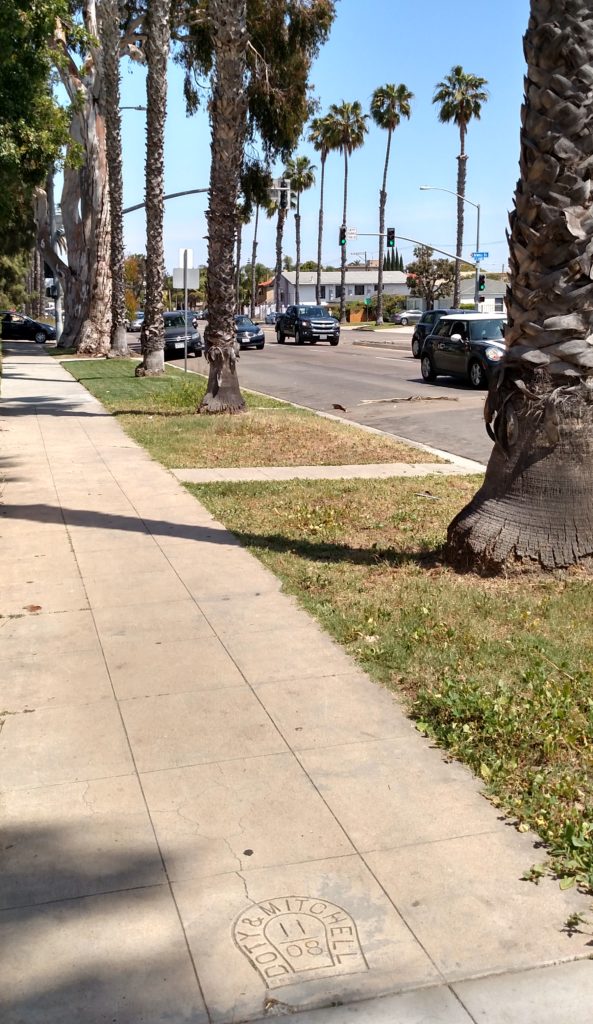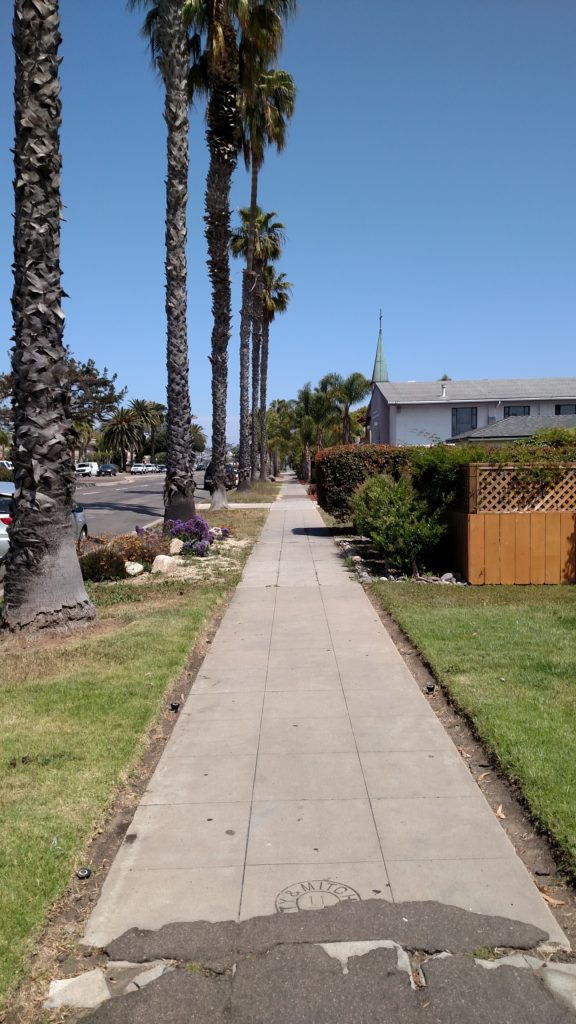The original 1887 subdivision map divided Pacific Beach into residential blocks separated by streets that were all 80 feet wide except for Broadway (now Ingraham Street), which was 100 feet, and Grand Avenue, which was 125 feet wide and included the right-of-way of the railway to downtown San Diego. The streets were set aside for public use and became city property, but were not initially developed or improved other than what was necessary to lay the railroad tracks on Grand Avenue. At the end of the nineteenth century Pacific Beach was primarily a lemon ranching area and the few residents got around on foot or horseback or in horse-drawn conveyances that didn’t require prepared roadways.
All of that began to change at the beginning of the twentieth century with the arrival of the Folsom brothers, Murtrie and Wilbur, and their brother-in-law A. J. Dula. In 1902 Dula and a partner purchased a tract of land south of what is now Pacific Beach Drive, subdivided it as Fortuna Park, and commissioned Folsom Bros. Co. to sell the lots. In 1903 Folsom Bros. also purchased most of the Pacific Beach subdivision, over 600 acres consisting of around 100 blocks and 4000 lots. To market this huge inventory of lots Folsom Bros. initiated a campaign to transform the semi-rural area into a residential community through a program of development and improvement. A full-page ad in the Sunday San Diego Union in December 1903 announced that ‘Our Actual Work of Development in Pacific Beach has Begun’ and featured a drawing showing workmen with horse-drawn equipment and steamrollers working on streets along with the explanation that ‘the activity displayed in the foregoing cut represents actual conditions which will be found there within two months’. One month later, in January 1904, the Union noted a great advance in the work of building and development by Folsom Bros., including a large force of men kept constantly employed in the work of street improvement.
Street improvement in the first years of the twentieth century began with grading; the city established the grade, or elevation, of intersections and gangs of men and teams of horses moved and smoothed dirt to make the surface of the streets align with the city grades. Street improvement was the responsibility of adjoining property owners and as owners of most of Pacific Beach Folsom Bros. Co. graded the streets at their own expense. They brought in a new road grader from San Francisco which proved itself to be ‘splendidly adapted for doing the work required with skill and rapidity’.
Although some graded streets were then sprinkled with crude oil to consolidate the surface and reduce dust and mud, paving streets with solid surfaces like concrete was still years in the future. What could be paved with concrete in the early 1900s were sidewalks, and in February 1904 Folsom Bros. also petitioned the common council to approve their design for sidewalks on the streets of Pacific Beach and Fortuna Park. Their petition proposed that for streets 80 feet wide or wider (the standard in Pacific Beach), 20 feet on each side be left as sidewalk space. For 75-foot-wide streets (the standard in Fortuna Park), 17 feet on each side should be left for sidewalk space. The Folsom Bros.’ petition was granted and an ordinance requiring the 20- or 17-foot sidewalk space was passed in March 1904. The ordinance also specified that when these sidewalks were paved the pavement would be 5’ 4” wide and located 4 feet from the property line and 10’ 8” from the curb on 80-foot streets, or 7’ 8” on 75-foot streets (leaving 40 and 41 feet, respectively, for the actual roadway).
Actual work on sidewalks in Pacific Beach did not begin immediately, however. In April 1904 Folsom Bros. Co. acquired the former San Diego College of Letters and most of the company’s development and improvement efforts were diverted to converting its buildings and grounds into a ‘first class resort’, the Hotel Balboa. Work on the streets resumed in 1906 when Folsom Bros. received city permission to grade the perimeter of the Hotel Balboa property; Garnet Avenue and Jewell, Emerald and Lamont streets. In February 1907 the council also granted a petition to grade Grand Avenue between Lamont and Izard streets, and Lamont and Kendall streets between Grand and Garnet avenues (Broadway, now Ingraham Street, was officially named Izard Street between 1900 and 1907). A Folsom Bros. ad in the Evening Tribune predicted that this street and sidewalk grading, to be followed by thorough oiling, cement sidewalking and curbing, would double and quadruple values in many sections of Pacific Beach (but that until development work was a little further along fine lots could still be had for from $150 to $350 each upon very easy payments).
Laying of cement sidewalks and curbs began at Pacific Beach on April 28, 1907, according to Folsom Bros. Co.’s ad in that evening’s Tribune. The contract for about a mile of concrete sidewalking and curbing had been awarded to Frank J. Over and that ‘from now on the work will proceed rapidly’. Pacific Beach had ‘passed the speculative stage’ and ‘with the making of this class of permanent and high-grade improvements, becomes daily a better and better place for safe and profitable investment’. An ad in May noted that street grading, cement sidewalking and curbing were going on and would continue until Pacific Beach had the finest streets and sidewalks in San Diego.
‘Many Sidewalks Now Being Laid – Large force at work improving streets at Pacific Beach’ was the headline of a San Diego Union article in August 1907. Cement sidewalks had been completed on Lamont and Kendall streets between Grand and Garnet avenues and on Grand from Lamont to Jewell Street. It was planned to continue sidewalking on Kendall from Grand to Reed Avenue and later extend it south to Mission Bay. Other streets to be sidewalked would include Jewell from Garnet to Emerald, Emerald from Jewell to Lamont, Lamont from Emerald to Garnet, Garnet from Lamont to Jewell and Hornblend from Jewell to Lamont; thus including ‘everything in the central portion of Pacific Beach north of Grand Avenue, which is really the center of the suburb, and the point to which business will naturally gravitate’. The Union article concluded that it was the plan of Folsom Bros. company and the residents of Pacific Beach to attain the highest possible standard of improvement in this center, and then work from this in all directions, as from the hub of a wheel.
A few weeks later the Union reported that development work at Pacific Beach had been steadily increasing for the past few weeks until quite an army of men were employed in the various enterprises. The cement sidewalking and curbing commenced three months ago and carried on ever since by Folsom Bros. Company at its own expense was now being continued by other owners by order of the city. Frank Over’s crews were working westward upon Grand Avenue and rapidly extending the sidewalks and curbs toward the ocean front. Sixteen thousand feet of cement sidewalk and nearly 500 feet of curbing had already been laid, and enough more was under way to make a total of 30,000 feet of sidewalk and 7000 feet of curbing (presumably the sidewalk numbers represented square feet, where 16,000 would be about 3000 linear feet, or 6 blocks). Over two miles of streets had been graded to full city grade and awaited their oiling. The Union added that three years previously a city ordinance established the sidewalk width for Pacific Beach streets at 20 feet, with a fine 10-foot parking strip between the curb and the cement walks; ‘As these streets are graded, sidewalked and curbed, and the parking strips planted to palms and lawns, their beauty appears’.
Sidewalking central Pacific Beach continued into 1908. In May the common council determined that sidewalks and curbs should be constructed on Hornblend Street from Jewell to Morrell streets, and that owners of property fronting on said street between said points who desired to construct sidewalks and curbs thereon by private contract must complete the work before September 7, 1908. Frank Over’s crews had apparently failed to complete their work on Grand Avenue so in July 1908 the common council adopted a resolution ordering the work of sidewalking and curbing Grand Avenue between Lamont Street and Broadway, including both sides of all intersections of streets between said points, excepting where already sidewalked or curbed with concrete. Apparently no acceptable bids were received and in September the council granted a petition from C. M. Doty, a Pacific Beach resident and cement contractor, to have the city clerk re-advertise for this work. This time Doty came in as the lowest responsible bidder and was awarded the contract to sidewalk and curb Grand Avenue in October 1908. Today pedestrians on Grand Avenue can still see ‘Doty & Mitchell Contractors 11/08’ stamped in the concrete sidewalks which, like the others in this former ‘center of the suburb’, are 5’ 4” wide, 10’ 8” from the street, and scored with the three-wide ‘sidewalk squares’ characteristic of the early 1900s.
Doty & Mitchell’s work on Grand Avenue turned out to be the last street improvement in the central part of Pacific Beach for many years. The new concrete sidewalks and curbs marked its transition from lemon ranch to residential blocks but did not generate the lot sales and increased property values that would justify continuing development into neighboring areas. Garnet Avenue and Cass Street, then sections of the coast highway between San Diego and the north, were paved with concrete in 1919. Diamond, Lamont, Ingraham, Allison (Mission Boulevard) and the streets in new subdivisions like North Shore Highlands and Pacific Pines followed in the 1920s, but most streets and sidewalks in Pacific Beach remained unpaved until the late 1940s and 1950s.
Postscript:
Sidewalks in the old central section of Pacific Beach are in the news again in 2017. Former San Diego Mayor Roger Hedgecock and his wife Cynthia are suing the city over a fall she took on a sidewalk that allegedly ruptured her silicone breast implants. Apparently a tree root had lifted a section of the sidewalk on Morrell Street near Grand Avenue about 2 ½ inches and Mrs. Hedgecock suffered serious injuries when she tripped over the raised portion, ‘flew forward and came crashing to the ground’ in 2015. For his part, Mr. Hedgecock suffered ‘loss of support, service, love, companionship, society, affection, relations and solace’ from his wife. He had been mayor of San Diego from 1983 to 1985, when he was forced to resign over a campaign finance scandal. The sidewalk in question had been paved in the mid-1950s.

